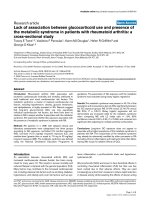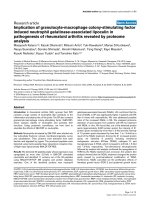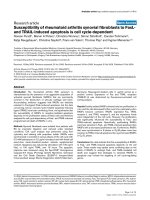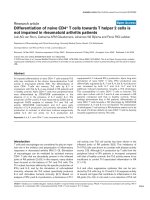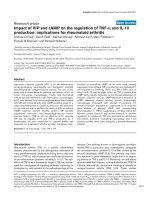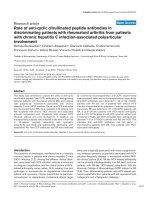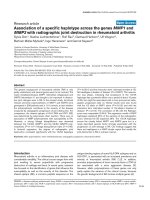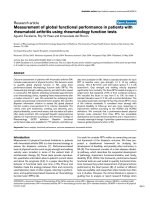Báo cáo y học: " Pathogenesis of rheumatoid arthritis: how early is early" pdf
Bạn đang xem bản rút gọn của tài liệu. Xem và tải ngay bản đầy đủ của tài liệu tại đây (40.8 KB, 3 trang )
157
IFN-γ = interferon gamma; IL = interleukin; RA = rheumatoid arthritis; Th = T helper cell.
Available online />Abstract
Studies of cytokine expression in rheumatoid arthritis have
provided key insights into the pathogenesis of disease and have
offered clues for effective therapy. Patterns of T-cell products in
chronic rheumatoid synovitis suggest that T helper type 1 cells
contribute to the perpetuation of disease. However, there is no
guarantee that the mechanisms of late disease are identical to very
early rheumatoid arthritis. Evaluation of the cytokine profile at the
earliest time points after onset of symptoms could identify novel
targets that prevent progression to chronic arthritis.
Development of hypotheses to explain the pathogenesis of
chronic rheumatoid arthritis (RA), including the interesting
new study by Raza and colleagues [1], has been a wondrous
adventure. Virtually every immune cell type and inflammatory
mediator has been implicated in the disease process at one
time or another. Older, temporarily discarded hypotheses on
B cells and immune complexes have enjoyed renewed energy
with the advent of anti-B-cell therapies [2]. Now that T-cell-
directed approaches, such as CTLA4-Ig [3], demonstrate
efficacy, it appears that therapies targeting this cell lineage
also are effective in a subpopulation of patients. Hence,
chronic rheumatoid synovitis is marked by a complex interplay
between multiple cell types, and individual patients display
their own distinct hierarchy for the efficacy of therapeutic
interventions [4].
On the other hand, there is much less information on disease
mechanisms in the earliest stages of RA. This is, in part, due
to the changing definitions of ‘early RA’, with a cutoff that has
gradually migrated from 2 years of symptoms to as little as
6 weeks. Even in the latter case, a prolonged preclinical
period of immune hyper-reactivity and asymptomatic synovitis
could exist before the disease becomes fully established.
Many investigators believe that an appropriate genetic
background in combination with stochastic events, such as
activation of innate immunity, can serve as the trigger for RA.
Subsequent perpetuation of the disease might involve entirely
distinct adaptive immune mechanisms that are independent
of the initiating events.
Implicit in this assessment, an adaptive T-cell response might
be required for full expression of RA. The nature of this
response remains poorly defined, and studies of chronic
rheumatoid synovitis have generally demonstrated blunted T-
cell function and surprisingly limited cytokine production
compared with other T-cell-mediated diseases. The lympho-
cyte cytokine profile in chronic RA synovium and surface
chemokine receptor display is most consistent with a T helper
cell type 1 (Th1)-driven disease [5]. This cell type plays a key
role in the pathogenesis of many rodent models of arthritis,
including collagen-induced arthritis, antigen-induced arthritis,
and adjuvant arthritis, where Th1 cytokines generally
predominate early and T helper cell type 2 (Th2) factors
contribute to the resolution. In this context, the study by Raza
and colleagues raises questions about the role of T cells in
RA and other forms of inflammatory arthritis.
Many studies have suggested that ‘chronic’ RA and ‘early’
RA have more similarities than differences [6].
Histopathologic evaluation of synovial tissue shows chronic
changes shortly after the onset of symptoms, and the
cytokine profile in early disease as determined by
immunohistochemistry is nearly identical to long-standing RA
[7-9]. The latter finding was based on patients with up to
1 year of disease, but some patients with synovitis for as
little as 2 months were included in the analysis.
Asymptomatic joints in patients with RA also have very
similar profiles to chronic RA, albeit with fewer synovial
macrophages and less immunoreactive IL-8 [10]. These data
suggest either that the mechanisms of RA in early disease
are the same as in late arthritis or that the window of obvious
T-cell activation needs to be pushed even earlier, perhaps to
the preclinical phase.
Commentary
Pathogenesis of rheumatoid arthritis: how early is early?
Gary S Firestein
Division of Rheumatology, Allergy and Immunology, UCSD School of Medicine, La Jolla, California, USA
Corresponding author: Gary S Firestein,
Published: 17 June 2005 Arthritis Research & Therapy 2005, 7:157-159 (DOI 10.1186/ar1780)
This article is online at />© 2005 BioMed Central Ltd
See related research by Raza et al., />158
Arthritis Research & Therapy August 2005 Vol 7 No 4 Firestein
The present study demonstrating T-cell cytokines in the first
few months of disease might provide some insights into the
time frame of T-cell activation in early RA. The data suggest
that T-cell cytokines might be abundant in the first 3 months
but that the levels later drift downward and are eventually
undetectable. However, there are some discrepancies with
many previous reports that remain unexplained. For instance,
IL-4 and IL-13 (both classic Th2 cytokines) but not interferon
gamma (IFN-γ) were detected early in RA, thereby making it
difficult to call RA a ‘Th1’-mediated disease. In contrast,
seronegative spondyloarthropathies had high IFN-γ, which is
the opposite of the ‘Th2’ pattern observed in chronic disease
[11]. The absence of IFN-γ in synovial effusions of patients
with chronic RA contrasts with other studies, including our
experiments over 15 years ago when we were impressed by
surprisingly low IFN-γ concentrations [12]. Although the
levels are below the amount required to induce HLA-DR on
monocytes, detectable amounts were clearly identified in
synovial effusions. Other cytokines previously reported in
chronic RA, such as granulocyte–macrophage colony-
stimulating factor and IL-17, were not detected with the
multiplex system employed by the authors [13,14]. In contrast
to previous studies, the levels of IL-15 were similar in chronic
RA and osteoarthritis synovial effusions [15].
The authors also comment on a potential role of stromal-
derived cytokines and growth factors in early RA and late RA.
Compared with the lengthy list of T-cell products and
macrophage products, the array of mesenchymal cell
products evaluated was more limited. Additional information
on key cytokines such as stromal derived factor 1,
transforming growth factor beta, and the bone morphogenic
proteins would be useful, even if individual immunoassays are
required to quantify these data [16,17].
Many of the differences with previous studies are difficult to
resolve and could be due to concomitant medications or other
confounding technical influences. The use of multiplex assay
systems is relatively new, and the correlations with standard
single analyte assays of complex body fluids would be helpful
to assess precision and accuracy. The authors did perform
several careful studies that appeared to rule out interference
by rheumatoid factors, although validation to evaluate the
effect of other synovial fluid constituents on multiplex analysis
and the antibody pairs is very important. Antibody pairs
validated for tissue culture supernatants or blood do not
always perform to specifications in more complex biological
samples or tissue extracts. One also needs to be cautious
about the use of synovial fluid as the ultimate arbiter of
synovial tissue cytokine levels. Synovial effusion levels could
reflect tissue concentrations, but the joint space is a separate
compartment with distinct cell populations and kinetics that do
not always mirror the synovium.
Despite these concerns, the questions addressed are indeed
quite important. Are there divergent mechanisms in early RA
and late RA, and is there a transient window for curing the
disease with aggressive therapy? Recent data using
infliximab in early synovitis, defined as less than 12 months of
symptoms, show that treatment can be withdrawn in some
patients without subsequent flares, supporting the authors’
contention that early RA has a distinct pathogenesis [18].
‘Early’ intervention (<18 months of disease) with anti-CD4
antibody, however, demonstrates little or no benefit even
though T cells were depleted from the synovium [19]. Both of
these studies were beyond the short window of elevated Th2
cytokine production observed in the present study.
Conclusions
Although data implicating Th2 cytokines in early arthritis differ
from our expectations, this information might influence our
concepts of how RA evolves. In light of the possible technical
issues related to multiplex analysis, confirmatory studies to
evaluate the cytokine profile in early synovitis are essential to
resolve the differences with previous work. If validated, a
careful reassessment of Th1/Th2 balance in early RA and late
RA would be important.
Competing interests
The author(s) declare that they have no competing interests.
References
1. Raza K, Falciani F, Curnow SJ, Ross EJ, Lee CY, Akbar AN, Lord
JM, Gordon C, Buckley CD, Salmon M: Early rheumatoid arthri-
tis is characterized by a distinct and transient synovial fluid
cytokine profile of T cell and stromal cell origin. Arthritis
Research & Therapy 2005, 7:R784-R795.
2. Edwards JC, Szczepanski L, Szechinski J, Filipowicz-Sosnowska
A, Emery P, Close DR, Stevens RM, Shaw T: Efficacy of B-cell-
targeted therapy with rituximab in patients with rheumatoid
arthritis. N Engl J Med 2004, 350:2572-2581.
3. Kremer JM, Westhovens R, Leon M, Di Giorgio E, Alten R, Stein-
feld S, Russell A, Dougados M, Emery P, Nuamah IF, et al.: Treat-
ment of rheumatoid arthritis by selective inhibition of T-cell
activation with fusion protein CTLA4Ig. N Engl J Med 2003,
349:1907-1915.
4. Firestein GS: Evolving concepts of rheumatoid arthritis. Nature
2003, 423:356-361.
5. Miossec P, van den Berg W: Th1/Th2 cytokine balance in
arthritis. Arthritis Rheum 1997, 40:2105-2115.
6. Tak PP: Is early rheumatoid arthritis the same disease
process as late rheumatoid arthritis? Best Pract Res Clin
Rheumatol 2001, 15:17-26
7. Kraan MC, Haringman JJ, Post WJ, Versendaal J, Breedveld FC,
Tak PP: Immunohistological analysis of synovial tissue for dif-
ferential diagnosis in early arthritis. Rheumatology (Oxford)
1999, 38:1074-1080.
8. Katrib A, Tak PP, Bertouch JV, Cuello C, McNeil HP, Smeets TJ,
Kraan MC, Youssef PP: Expression of chemokines and matrix
metalloproteinases in early rheumatoid arthritis. Rheumatol-
ogy (Oxford) 2001, 40:988-994.
9. Smeets TJ, Dolhain RJEM, Miltenburg AM, de Kuiper R, Breedveld
FC, Tak PP: Poor expression of T cell-derived cytokines and
activation and proliferation markers in early rheumatoid syn-
ovial tissue. Clin Immunol Immunopathol 1998, 88:84-90.
10. Kraan MC, Patel DD, Haringman JJ, Smith MD, Weedon H, Ahern
MJ, Breedveld FC, Tak PP: The development of clinical signs of
rheumatoid synovial inflammation is associated with
increased synthesis of the chemokine CXCL8 (interleukin-8).
Arthritis Res 2001, 3:65-71.
11. Simon AK, Seipelt E, Sieper J: Divergent T-cell cytokine pat-
terns in inflammatory arthritis. Proc Natl Acad Sci USA 1994,
91:8562-8566.
159
12. Firestein GS, Zvaifler NJ: Peripheral blood and synovial fluid
monocyte activation in inflammatory arthritis. II. Low levels of
synovial fluid and synovial tissue interferon suggest that
gamma-interferon is not the primary macrophage activating
factor. Arthritis Rheum 1987, 30:864-871.
13. Xu WD, Firestein GS, Taetle R, Kaushansky K, Zvaifler NJ:
Cytokines in chronic inflammatory arthritis. II. Granulocyte–
macrophage colony-stimulating factor in rheumatoid synovial
effusions. J Clin Invest 1989, 83:876-882.
14. Chabaud M, Durand JM, Buchs N, Fossiez F, Page G, Frappart L,
Miossec P: Human interleukin-17: a T cell-derived proinflam-
matory cytokine produced by the rheumatoid synovium.
Arthritis Rheum 1999, 42:963-970.
15. McInnes IB, al-Mughales J, Field M, Leung BP, Huang FP, Dixon
R, Sturrock RD, Wilkinson PC, Liew FY: The role of interleukin-
15 in T-cell migration and activation in rheumatoid arthritis.
Nat Med 1996, 2:175-182.
16. Nanki T, Hayashida K, El-Gabalawy HS, Suson S, Shi K, Girschick
HJ, Yavuz S, Lipsky PE: Stromal cell-derived factor-1-CXC
chemokine receptor 4 interactions play a central role in CD4
+
T cell accumulation in rheumatoid arthritis synovium.
J Immunol 2000, 165:6590-6598.
17. Lories RJ, Derese I, Ceuppens JL, Luyten FP: Bone morpho-
genetic proteins 2 and 6, expressed in arthritic synovium, are
regulated by proinflammatory cytokines and differentially
modulate fibroblast-like synoviocyte apoptosis. Arthritis
Rheum 2003, 48:2807-2818.
18. Quinn MA, Conaghan PG, O’Connor PJ, Karim Z, Greenstein A,
Brown A, Brown C, Fraser A, Jarret S, Emery P: Very early treat-
ment with infliximab in addition to methotrexate in early,
poor-prognosis rheumatoid arthritis reduces magnetic reso-
nance imaging evidence of synovitis and damage, with sus-
tained benefit after infliximab withdrawal: results from a
twelve-month randomized, double-blind, placebo-controlled
trial. Arthritis Rheum 2005, 52:27-35.
19. Tak PP, van der Lubbe PA, Cauli A, Daha MR, Smeets TJ, Kluin
PM, Meinders AE, Yanni G, Panayi GS, Breedveld FC: Reduction
of synovial inflammation after anti-CD4 monoclonal antibody
treatment in early rheumatoid arthritis. Arthritis Rheum 1995,
38:1457-1465.
Available online />


